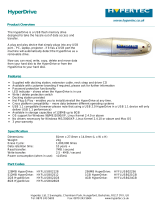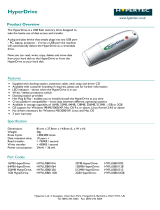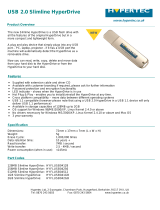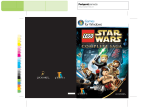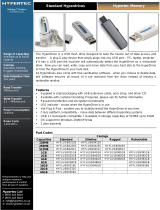Page is loading ...

Booklet available in English on
Heft in deutscher Sprache erhältlich auf
Livret disponible en français sur
Libretto disponibile in Italiano su
Folleto disponible en español en
Folheto disponível em português em
A füzet magyarul ezen a honlapon olvasható:
Buklets latviešu valodā pieejams vietnē
如需中文版手册,请访问
LEGO.com/starwars
ULTIMATE COLLECTOR SERIES
7 5181

2
“WE’RE STARTING OUR ATTACK RUN!”
Design Director: Jens Kronvold Frederiksen / Model Designer: Jordan David Scott / Graphic Designer: Madison O’Neil

3
LEGO®
Star Wars
started in 1999 and we have made new models for the product line every year
since then. The LEGO
Star Wars
design team consists of eleven model designers and four graphic
designers. The team is a mix of brand new designers with new fresh ideas, and experienced LEGO
Star Wars
designers with many models under their belts.
This is an ideal team for creating new, innovative LEGO
Star Wars
models, as well as revising
and improving previous LEGO versions of classic and iconic
Star Wars
ships. The focus of our
main LEGO
Star Wars
product line is to make cool, fun and inspiring LEGO
Star Wars
models for
children.
For LEGO Direct, we have the opportunity to make even bigger, more challenging models with
special attention to accuracy and details. These models are fun and exciting to develop,
but also a huge challenge! We always do our very best, and hope you will enjoy building it.
Happy building!
Jens Kronvold Frederiksen
Design Director, LEGO
®
Star Wars
™
ABOUT THE LEGO®
STAR WARS
DESIGN TEAM

4
ABOUT THE Y-WING STARFIGHTER™
Glistening with stardust and laden with heavy proton bomb payloads, the Y-wing
was a robust fighter-bomber originally designed for use in the Clone Wars. This
long-range bomber was eventually superseded by capital ships in the Imperial
Starfleet however; so surplus ships were sold, reclaimed, or stolen for use in the
Rebellion. Nicknamed “wishbone” by the rebels who used this spacecraft, due
to its shape, the Y-wing became an invaluable resource in the fight against the
Galactic Empire.
The Y-wing’s design was well-shielded and included aesthetically pleasing
fuselage plating when first introduced during the Clone Wars, but the superficial
hull plating required continued maintenance, and had to be removed each time
work was needed on the interior of the ship. Thus, when the Y-wing was enlisted
into service for the Rebel Alliance, many maintenance crews left off the plating
entirely, leaving the main hull exposed. This change lightened the weight of
the spaceframe and also served to cool the engines faster, which boosted the
performance of the Y-wing.
With a powerful ordnance and reliable hyperdrive, the Y-wing was used in
numerous conflicts. The sturdy hull and defensive shields allowed the ship
to survive flak hits during bombing runs, but due to its speed, the Y-wing was
vulnerable in dog fights with the much faster TIE fighters. As a testament to the
Y-wing’s utility, the rebel group on Yavin 4 stocked its Gold Squadron entirely with
powerful Y-wings.
Ralph McQuarrie © & ™ Lucasfilm Ltd.

5
FACTS/SPECIFICATIONS
BTL Y-wing Facts
Manufacturer
Koensayr Manufacturing
Model
BTL Y-Wing Starfi ghter
Affi liation Rebel Alliance
Technical Specifi cations – BTL Y-wing
Length
16.24 meters
Height
2.44 meters
Maximum atmospheric speed 1,000 km/h
Hyperdrive rating
Class 1.0
Armament Taim & Bak IX4 laser cannons (2)
SW-5 ion cannons (2)
ordnance launcher
Engine unit
Turbo-modifi ed R200 starboard ion engine
Crew 1 pilot
Astromech droid
© & ™ Lucasfi lm Ltd.

6
Q: The Y-wing was known for having removable hull plating that was often
left off. What techniques did you use to ensure the model would be robust
enough with so much fuselage exposed?
A: When I started to build the Y-wing, I knew that the engines on the sides
were going to be my biggest problem. They are very long and very thin. This
also affected the balance point and made locking these engines quite tricky. I
tried a few different designs, but in the end it turned out that a simple Technic
frame and some very stable cross axles were all I needed to make it strong
and easy to build. This allowed me to hide the entire construction in the
amazing details of the Y-wing’s exposed fuselage.
Q: What sets the Y-wing apart from other LEGO
Star Wars
sets?
A: I think this is one of the few UCS
Star Wars
sets that has so much greebling,
literally every part of the model is packed with intricate small details and builds.
MEET THE MODEL DESIGNER
Q: There are many unique and storied vehicles in the
Star Wars
universe. What is the process behind choosing the next amazing LEGO®
Star Wars
vehicle the team will create?
A: Deciding the next model is a long process with many factors in play!
First, we look at our fans’ feedback and requests for new potential
models. We also look at earlier versions of a potential new model; how
long ago was it launched and how can we improve it in a new version?
Finally, if there is a new
Star Wars
movie out, or other relevant content,
this can also infl uence our choice for a new model.
Q: There are several different versions of the Y-wing; the BTL-S3
two-man strike fi ghter, the BTL-A4 with a front-facing ion cannon, the
“Longprobe” model and of course, the very fi rst version, the BTL-B.
How did you decide which Y-wing version would be built in LEGO brick
form?
A: We wanted to make the most iconic depiction of the Y-wing from the
Star Wars
universe. The BTL-A4 Y-Wing Starfi ghter appears in
Star Wars
Episode IV:
A New Hope
in the trench run scene. It is one of the most
iconic
Star Wars
scenes, so we had to go with this version.
Jordan David Scott
© & ™ Lucasfi lm Ltd.
Jordan David Scott

7
Q: What features of the Y-wing were important for you to include in the
fi nal design?
A: When looking at the reference images, I particularly liked the sand blue
stripe running down the side of the cockpit. The stripe made for an interesting
build but I think it worked out, and a similar technique was used on the smaller
retail product from
Rogue One
. Another detail I wanted to keep, like in the
UCS Snowspeeder I worked on, was the detailed underside of the model. I feel
it is very important to make sure that no matter which part of the model you
look at, there are accurate details from the movie.
Q: What goes into the colour selection of the LEGO bricks used to create
the model? Do you try to match the colours of the vehicle from the fi lm, or
are there other elements taken into consideration?
A: For the exterior of the model, we defi nitely have to match it as closely as
possible. Luckily, the Y-wing is quite muted in colour but with some nice accents.
For this, I used lot of grey and dark grey but then added in some splashes of
brown and dark red for piping and dark tan for some more rusty, worn details.
Inside, the model is quite colourful to make the building experience easier. I
am from Scotland so I always try to hide a blue and white brick in the build
somewhere. The cockpit is all white, so that wasn’t too diffi cult!
© & ™ Lucasfi lm Ltd.
Q: Was any part of the Y-wing particularly challenging to recreate with
LEGO® bricks? How did you solve the problem?
A: Most defi nitely. The engines on the sides as I mentioned were very tricky
to make stable, but the most challenging part was that they are cylinders.
The previous version of the UCS Y-wing was more square in its construction,
so I wanted to try and improve this, but it led to a lot of building challenges.
The support pylons that run all the way down the engines are built on 4 sides,
which is easy to build. However, the challenge was then attaching the whole
engine to the chassis of the model. My connection points were on the same
angle as the support pylons, which isn’t accurate. I had to use some very weird
builds with turntables to get this 45-degree angle connection point. After that,
I still had to build in the details and make it look round. It was a big challenge
but I am glad it paid off in the end, and I think it looks pretty accurate... I hope
fans do, too.
Q: How accurate is the LEGO Y-wing, compared to the real in-universe
vehicle?
A: In my eyes, it’s pretty accurate. I had a lot of great reference from Lucasfi lm
and model kits around the offi ce. However, like the studio-scale models,
several were used for fi lming different scenes, so it was very diffi cult to
pinpoint exactly which Y-wing I was building from. In the end, I would say the
LEGO® Y-wing is a combination of a few different models.

8
Q: Are there any memorable details from the movie versions of the
minifi gures that were important for you to incorporate in the fi nal design?
A: Most important in this set was of course the helmet of Gold Leader, a.k.a.
Jon “Dutch” Vander. The olive green colour and the symbols on its sides make
it quite unique.
Q: What do you fi nd enjoyable about the minifi gure design process?
A: I have the good fortune of being both a huge
Star Wars
fan and a huge
LEGO fan, so being able to translate characters from one beloved universe
to another is a truly special experience for me. If I had to pick a favorite part
of the process, it would have to be the full completion of a design, which to
me is when I receive the printed elements for the fi rst time and can hold the
character in my hands.
MEET THE GRAPHIC DESIGNER
Madison O’Neil
Madison O’Neil
Q: How do you begin the graphic design process for a new set and new
minifi gures?
A: When the graphic design process begins, we usually have a solid idea of
which characters we want to include. From that point, I move to reference-
gathering and graphic design exploration. Exploration usually involves
creating several different versions of the same design, playing with the colour
choices and sizes of elements. I will occasionally sketch by hand, but most of
the time I start directly in Adobe Illustrator. We then have several rounds of
discussions and reviews within the
Star Wars
graphic design team to make
refi nements, and of course Lucasfi lm approval is the fi nal step where revisions
may be required.
Q: What challenges do you face when creating designs that need to be
recognisable and suffi ciently detailed, but also small enough to fi t on a
minifi gure?
A: The greatest challenge comes from
Star Wars
characters that are overloaded
on detail. A standard minifi gure is tiny, and very differently proportioned from
an actual human. Fitting in all the important details can sometimes feel like a
jigsaw puzzle. But, part of the LEGO® DNA is simplifi cation. We determine the
most important details to prioritise in our characters, perhaps eliminating small
things that add little value to a design at this scale.
© & ™ Lucasfi lm Ltd.

9
© & ™ Lucasfi lm Ltd.
Control Panels
Y-Wing PilotAstromech Droid
Q: What do you use as reference material for designing the minifi gure decos?
Film stills? Licensed art?
A: This can depend largely on which fi lm the character is from. If the fi lm hasn’t
been released yet, we will receive concept art and turn-around images of the
character to work from. If the character is from the original trilogy or prequels,
I prefer to go back and collect stills directly from the fi lms. I feel that this
provides the best representation of how the audience will have experienced a
given character, and also provides a good excuse for me to watch
Star Wars
at work! For Gold Leader, I collected images from A New Hope and even
referenced his brief cameo appearance in Rogue One.
Q: Characters from the
Star Wars
universe are very detailed. How do you
pick and choose which details to bring to life, and which are ultimately not as
important in the fi nal design?
A: I think it comes down to scale and impact. We have many design
requirements when it comes to ensuring quality graphics, like minimum stroke
thicknesses and dot size. Some details on characters are too small to include
simply due to our guidelines. Other small details might be weeded out because
they are not as impactful... they are not the things a fan will remember about
the character. The most interesting and memorable features are always
accentuated.

10
2
1
3
4
LEGO.com/brickseparator

11
1
1
4
4
7
7
3
3
6
6
2
2
5
5
8
8

12
9
9
11
11
11
12
12
12
13
13
13
10
10
10

13
4x
4x
1x
1x
1
3x
2
1x
1x
3
1
1

14
4x
1x
2x
4
1x
4x
1x
5
1
2

15
8
1x
6
3x
7

16
1x
2x
2x
9
1x
2x
1x
10

17
1x
2x
1x
1x
1x
1x
11
12
1x
2x
1x
1x
1x
1x
1
2
3
1
2
3

18
1x
1x
13
1x
2x
14

19
16
1x
1x
1x
2x
1x
2x
15
1x
1x
1x
2x
1x
2x
1
2
3
4
1
1
2
2
3
4

20
4x
1x
17
1x
2x
1x
2x
18
/
